|
|
The Blakely Burl Tree Project: The
Story
|
The Blakely Burl Tree Project:
From The Ground Up
by Terry Martin |
THE STUDIO
ARRIVING AT LINDQUIST STUDIOS
We arrive late Monday afternoon at
Lindquist Studios in Quincy and as we drive across the fields we are greeted by
the exuberant sounds of barking dogs. Mark’s wife Kathy keeps several dogs and
the animals are excited by the arrival of so many strange vehicles.

Lindquist Studios, Quincy, Florida. Shade leaf tobacco barn and brick
packing plant on 25 acres, converted into artist's studio and living quarters in
1983.
Photo:
Mark Lindquist
Some of them
run back and forth excitedly, barking in belled tones as a group welcome. The
alpha dog puts on a territorial display, bracing his legs and barking the
shorter, sharper challenges that ask us what we think we are doing there.
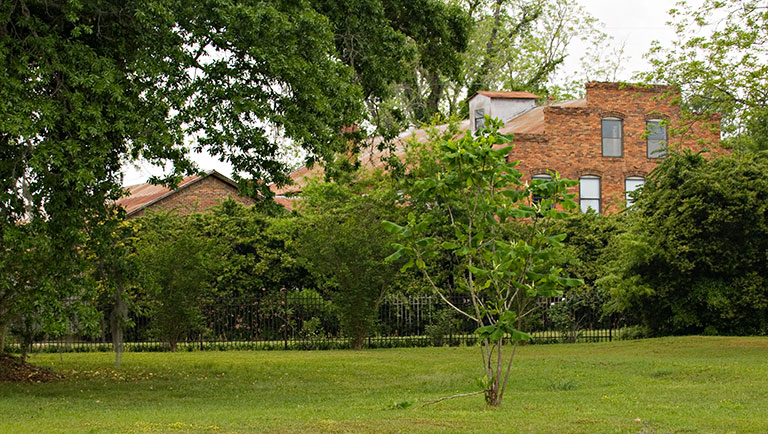
Roadside view of The Compound, Lindquist Studios, Quincy, Florida. Photo:
Mark Lindquist
We pull in beside the rambling complex of buildings that once was used for
processing shade tobacco. It is an incongruous structure, stuck out in the
middle of nowhere surrounded by gently sloping fields that were once productive
tobacco farms. The buildings date to the early 1900s, but resemble something
much older, like an urban 19th century factory. Mark has subdivided the huge
spaces and added outbuildings to create a rambling rabbit warren containing
their home, three separate galleries, photography studios, computer rooms, and
workshops of every size and type imaginable.
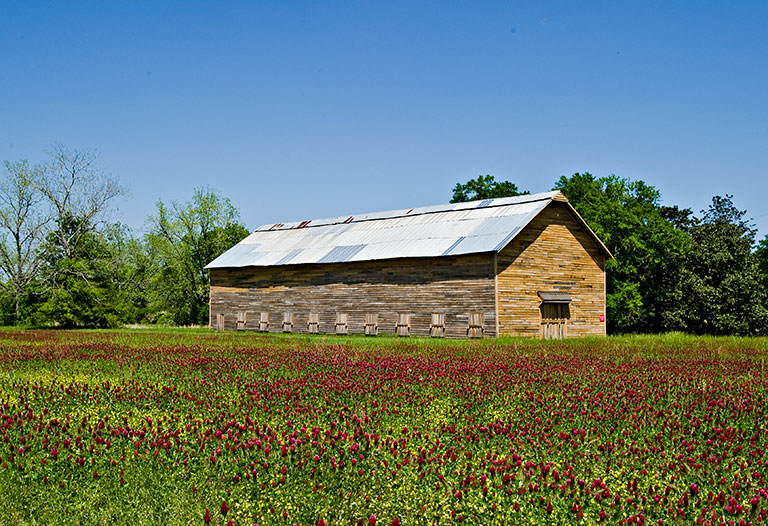
The tobacco barn, recently resided. Built in the early 1900's during
the shade leaf tobacco era. Shade leaf tobacco was grown for cigar
wrappers. The barn is the last of 24 orignal barns on the adjacent
properties.
Photo:
Mark Lindquist
A large gallery at the entrance is filled with Mark’s photographs, paintings,
and small sculptures, another with his large-scale sculptures.
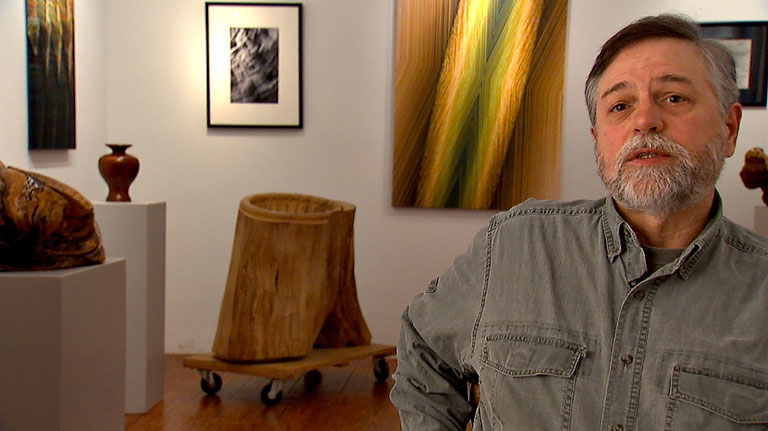
Mark Lindquist in his front gallery, Lindquist Studios, Quincy, Florida. Photo:
John McFadden
Two upper levels
are reached by a clanking one-hundred-year-old industrial elevator, and they
contain what seems to be acres of precious wood stored for future use. There are
also dozens of partly finished sculptures gathering dust until Mark is ready to
complete them. Everywhere is storage, storage and more storage.
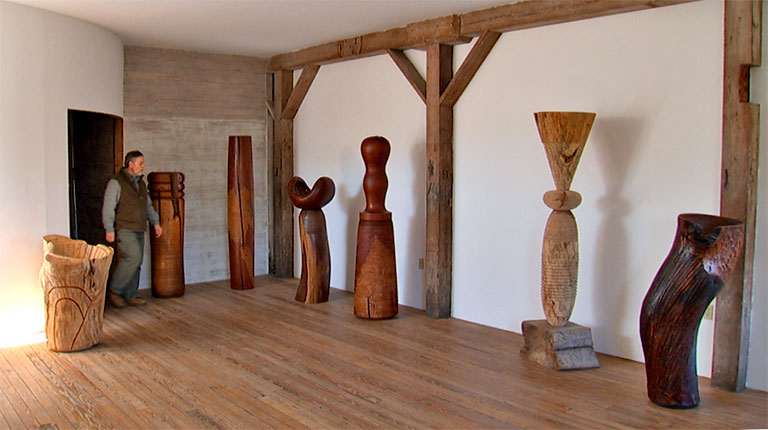
Lindquist in his second floor sculpture gallery above the main studios.
Photo: Greg Andracke
One workshop is filled with metal and wood lathes, surrounded by stacks of
drawers filled with every accessory imaginable.
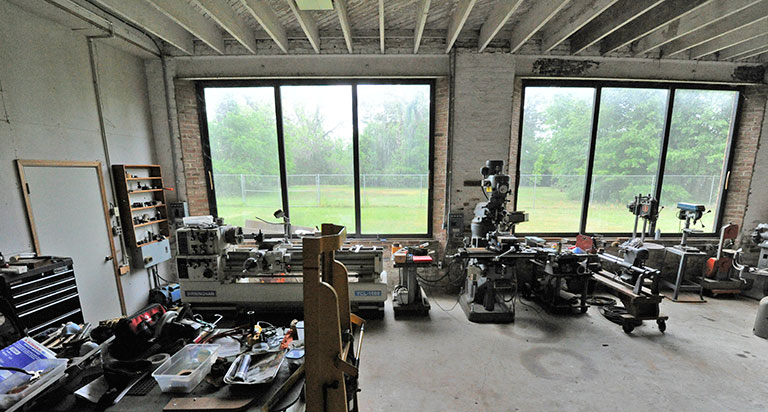
The front studio, machine shop. Lindquist Studios, Quincy, Florida.
Photo:
Mark Lindquist
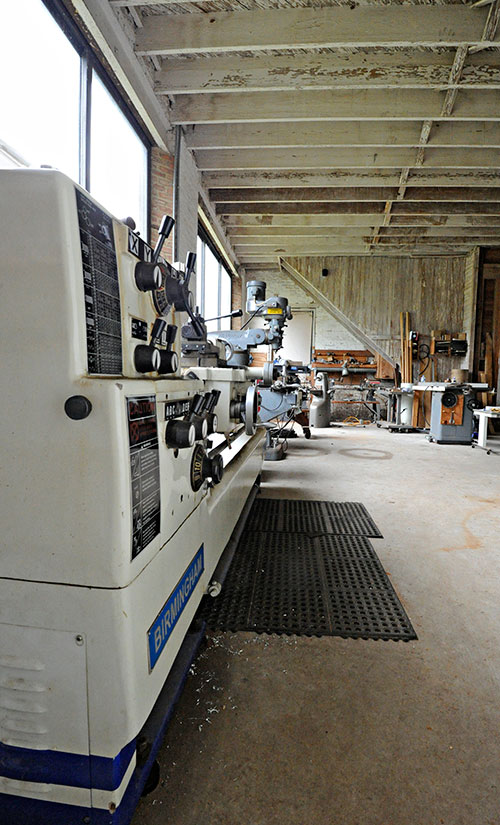
The machine lathe and tool room with Bridgeport milling machine and
Birmingham lathe. Photo:
Mark Lindquist
Another space contains Mark’s
futuristic robotic setups that enable him to work enormous pieces of wood with
little physical effort. It is a tool junkie’s paradise, the result of two
lifetimes’ accumulation by both Mel and Mark, a remarkable collection of
functioning machinery and things that “might be useful one day.”
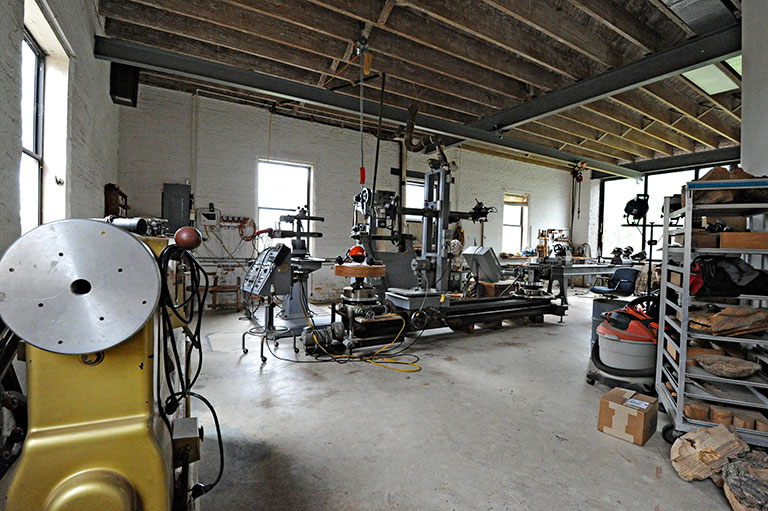
Lindquist's back studio with robotics and controls. Mark Lindquist has
been designing and building his robotic equipment and this main studio since
1985.
Photo:
Mark Lindquist
It's time for dinner so we drive into town to eat at the West End Grille where
the steaks are thick and the sauces are hot. As we settle in with the menus, I
sigh and, not for the first time, look down at my waistline. This has not only
been a life-changing experience, but a body-changing time as well. But before we
can order, we hear a shout from across the room and look up to see Steve Cross
weaving his way through the tables to us! He has followed us down only a few
hours after we left and knew we would be eating here. Of course everybody laughs
and welcomes him, but we have to ask why he is here. He grins broadly and says,
“I might have a surprise for you.” He won’t tell us any more and so we happily
share dinner with our unexpected and most welcome guest.
When dinner is over Steve says, “It’s been real good seeing y’all again, but
before I go home I’ve got something for you in my truck.” We follow him across
the car park and he whips a tarpaulin aside to reveal a large, freshly cut piece
of black persimmon! He can barely contain his glee when he sees the looks on our
faces. “I thought y’all might like to try a piece,” he says. It’s impossible not
to feel deeply moved by this gentle man. This time it is our turn to watch sadly
as Steve returns home to complete his round trip of five hours just to make us
happy with a piece of wood. On the way home John talks about Steve: “You
know,” he says, “as we grow we learn to protect ourselves by not telling people
what we are actually thinking, but I don’t think Steve ever learned that. He is
such a genuinely kind person and so generous. He’s one of the truest southern
characters that I’ve ever met. I just can’t think of the Project without him.”
When we arrive back at Lindquist Studios, we sit on the porch with cold beers in
our hands, telling Kathy about what we have been doing. It makes me think about
how much we have been surrounded by men and I start wishing I could share this
moment with my wife Yuriko. Somebody says, “why don’t you call her?”, so I take
out my laptop and soon we are all gathered around, listening over the Internet
to her distant voice from Brisbane, 9000 miles away on the other side of the
world. She is surprised and delighted to hear from us all, and laughs at our
stories. Later I think about how this is a foretaste of the international nature
of the Rices' and Mark’s dream. If the dream comes true, threads of creativity
will link artists all over the world with the town of Blakely. I can’t help
thinking of a large map in the Blakely Burl Tree Museum with lines drawn to show
where the wood traveled to and how it came back to south Georgia.
|
|